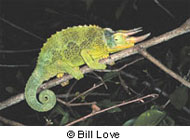Description:
Jackson’s chameleons are equipped with opposable toes, prehensile tails, independently rotating eyes and specialized tongues for snaring insects. Male Jackson’s chameleons have three rostral projections (“horns”) that they use for combat with other males. (House male Jackson’s chameleons separately from other males.) Jackson’s chameleons do best when provided with both an indoor and outdoor enclosure. To get maximum airflow, use a screened indoor enclosure sized at least 3 feet tall by 2 feet wide by 2 feet long. Provide a bush, such as a jade tree or tropical fig, for each Jackson’s chameleon. Jackson’s chameleons also benefit from full-spectrum lighting and a 50- to 75-watt basking light. Daytime temperatures should be 74 to 79 degrees Fahrenheit, with nighttime temperatures falling into the 50s and 60s. Remember to mist the Jackson’s chameleon’s cage several times a day and to keep this sensitive reptile in a quiet room away from small children and dogs and cats. Jackson’s chameleons eat crickets, giant mealworms and wax worm adults and larvae. Wild insects may also be offered. Variety is the key to a good diet. Dust feeder insects with a reptile mineral and vitamin supplement every third or forth feeding. Gut loading the feeder insects is also a good idea. For more information, read our detailed Jackson's chameleon care sheet.
Habitat:
Humid, high altitude areas.
Range:
Mountain regions of East Africa. Introduced in Hawaii.
Scientific Name: Chamaeleo jacksonii xantholophus
Species Group: chameleon
Family: Chamaeleonidae
Size: Average size is 12 inches.
Level: intermediate
Weight:
Dangerous: No



